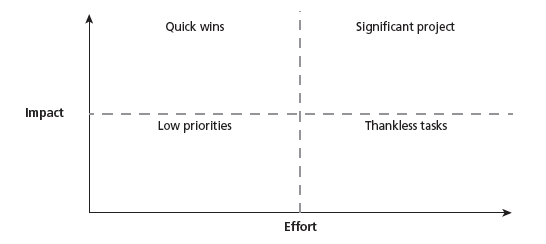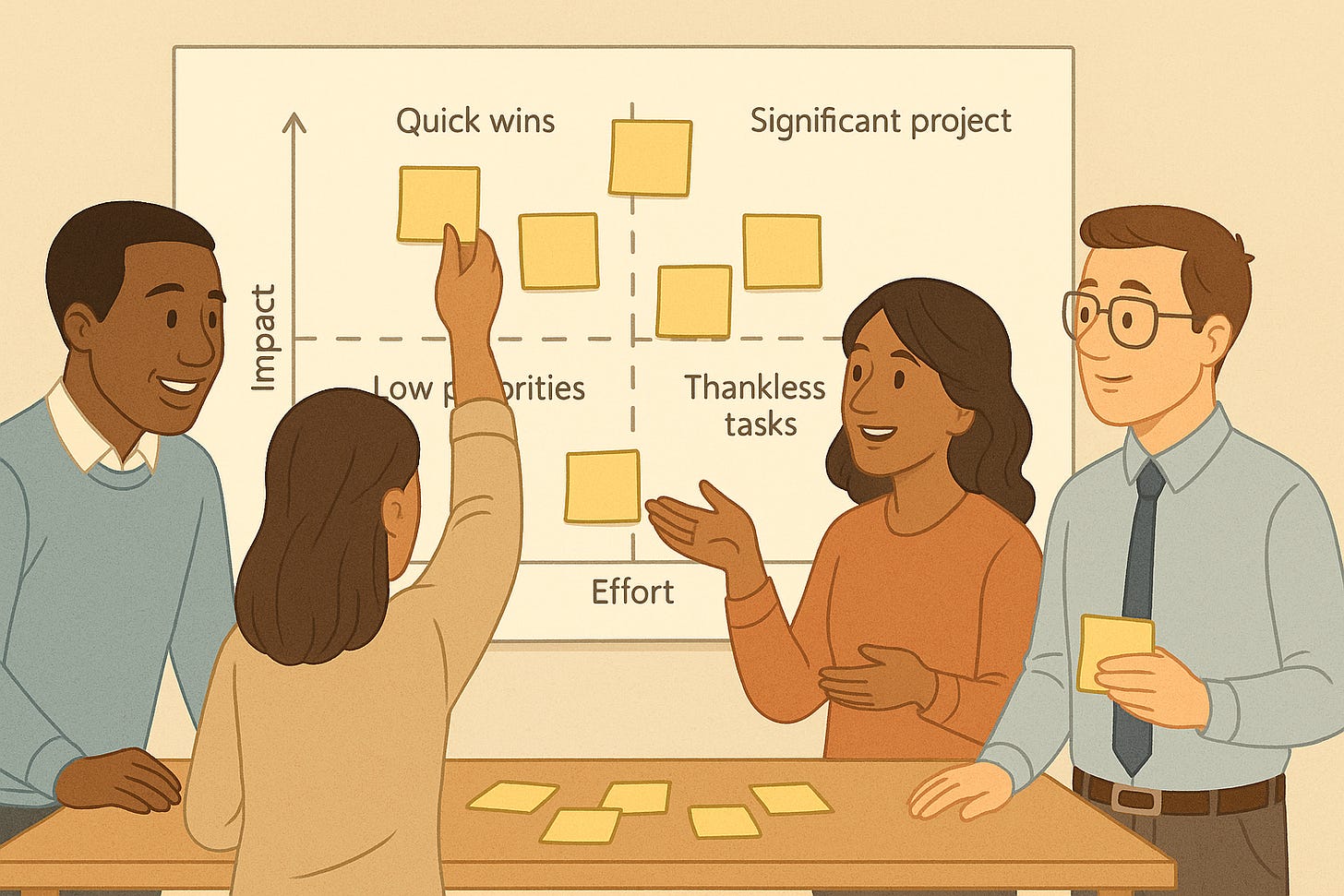Quick wins, thankless tasks and best bets... How to choose the right improvement focus
A simple tool to help your team cut through the noise and act with purpose
Firstly, a huge thank you to all the brilliant school leaders who shared their thoughts on my last post Making school improvement manageable: When everything feels urgent, how do you choose what matters most? over on LinkedIn. There’s an absolute treasure trove of wisdom in these comments. Please keep ‘em coming!!
In this post, I’d like to share a simple but powerful strategy I’ve been using with schools for the last few years for how to prioritise on the most impactful things.
In my last post, we created a long-list of 5-7 potential avenues of school improvement. For each item on your list, we reflected on where you are now, where you'd like to be, and how important it is to close that gap.
In this post, we’ll take the next step. Write each item from your list on a separate post-it note – just the name of the gap (e.g. ‘Year 8 behaviour’, ‘Quality of meetings’, ‘Staff wellbeing’).
The priority matrix
A priority matrix is a simple but powerful tool for deciding which ideas are worth pursuing first. It’s a two-axis graph with effort on the x-axis, and impact on the y-axis. If you divide each axis in half, you get four quadrants:
Let’s explore each in turn, starting top-left and moving anticlockwise.
Quick wins
These are high-impact, low-effort changes.
For example, I once taught in a school with a major litter problem. One day the senior team took decisive action: pupils were only allowed to eat in the canteen. The litter problem disappeared overnight.
Other examples of quick wins might include:
Teachers meeting and greeting pupils at the door to ensure a positive, ordered start to the lesson.
Clocks and displays placed at the back of the classroom to reduce distractions.
Hosting parents’ evenings online instead of in person to save valuable teacher time.
These things are easy to implement, and they make a noticeable difference. They’re quite rare - if you identify one, you should probably act on it immediately.
Low priorities
These tend to be low-effort, low-impact activities. They might not do any harm, but they’re unlikely to shift the dial on anything important – and they take up valuable time.
Examples might include:
Teachers saving lesson plans to a shared drive using a standard proforma.
Pupils filling in self-assessment reflection sheets.
Routine ‘book looks’ to check if marking policies are followed.
There may be a case for doing these things from time to time, but they aren’t usually seen as being urgent or impactful.
Thankless tasks
High effort, low impact. Think: onerous marking policies that require hours of written feedback each week, or lengthy report writing that no one really reads.
Other examples might include:
Regularly updating wall displays in classrooms and corridors.
Overly frequent data harvests.
Repetitive admin tasks that add little value.
These are the kinds of things that drain staff energy without a clear return. They’re best avoided if possible – or at least streamlined.
Significant projects
This is the upper-right quadrant: high-effort, high-impact.
This is the big stuff – the work that really matters - which the Making Change Stick programme is designed to support. Significant projects tend to have two key characteristics:
They affect a wide range of people across the school – pupils, teachers, leaders, support staff, parents.
They take time. You’re not going to change the culture overnight. This is long-haul stuff.
Here are some examples of the kinds of significant projects schools often focus on:
Running the exercise
Draw a large version of the priority matrix on a whiteboard. Then, as a group, decide where to place each sticky note. This often sparks rich discussion – you might hear things like:
“I think that’s more of a quick win than a significant project, because…”
“It’s definitely high impact, but it’s going to take serious effort to make it happen…”
‘I think it should be a bit lower or further to the left, because…’
Don’t worry if there’s disagreement – in fact, that’s often useful. Your goal is to reach a shared understanding of which options are worth pursuing, and which ones can wait (or be parked altogether).
Once you’ve populated the matrix, step back and look at the big picture. Do any of the items stand out as your top candidate for improvement? You might find it helpful to rank them – first, second and third choice – and explore whether there’s consensus among the team.
And if there isn’t consensus yet? Don’t worry. That’s what the next activity is for.
In my next post - the third in this mini-series of three on deciding where to focus your efforts and limited resources - we’ll look at one final step to help you sharpen your focus: values mapping – a powerful exercise to help ensure that your improvement efforts are aligned with what really matters to your school community.
In the meantime, I’d love to hear your thoughts. Have you used a priority matrix before? What other tools or techniques have helped you choose what to focus on? Feel free to share in the comments – I’d love to learn from your experience!




